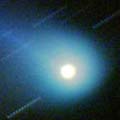
|
The brightness evolution had been slower than a typical comet since its discovery until the perihelion passage in early April. In March when it was finally observable in the Northern Hemisphere, it suddenly became bright and large as 7.8 mag and 6 arcmin (Mar. 8, Seiichi Yoshida), however, the brightening stopped after that. Actually, it is 8 mag still now in the southern sky. However, it is unusual that the brightness by CCD observation was also 8.0 mag (Apr. 4, Ken-ichi Kadota), very similar to the visual observations. It turns to be fading after this. It keeps observable for a long time in the Southern Hemisphere after this. However, it is not observable in the Northern Hemisphere until late September when it appears very low sky at dawn as 14 mag. Unusually strong non-gravitational parameters are revealed by the orbital calculation, but the reason has not been revealed yet.
Date(TT) R.A. (2000) Decl. Delta r Elong. m1 Best Time(A, h)
May 7 1 54.72 -38 56.1 1.150 1.046 57 8.4 5:14 (301, 25)
May 14 2 48.61 -40 2.4 1.229 1.122 59 8.8 5:19 (305, 21)
|

|
It was fantastic, so bright as 3.5 mag, so large as 30 arcmin, locating high overhead at its best time in early January. Then it has been getting fainter and smaller gradually, and 8.3 mag now (May 3, Reinder J. Bouma). Although it became too faint to see with naked eyes, it is still easy to see with binoculars because moderately condensed as DC=5. It looks rather small with a diameter of about 7 arcmin. It is visible all night in the Northern Hemisphere. In the Northern Hemisphere, it keeps observable in good condition for a long time while the comet is bright enough visible visually until October when it becomes faint as 14 mag.
Date(TT) R.A. (2000) Decl. Delta r Elong. m1 Best Time(A, h)
May 7 12 18.07 58 2.8 1.514 1.938 98 8.8 21:17 (180, -3)
May 14 12 25.58 54 23.9 1.611 2.014 97 9.1 20:57 (180, 1)
|
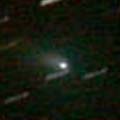
|
In January when it was visible in the Northern Hemisphere, it was an 11 mag small object. However, after it has gone to the southern sky, a very large appearance, 9.2 mag and 8 arcmin, was observed on Feb. 14 (David Seargent). The size became a bit smaller after that, about 3-5 arcmin, however, it keeps 8.0 mag, bright enough to be visible with binoculars, from March to April (Mar. 4 and Apr. 7, Alexandre Amorim). But it has already started fading. It had been very low even in the Southern Hemisphere for a while, but it will be higher again after this, and keeps observable while fading gradually. In the Northern Hemisphere, it is not observable until June when it appears in the morning at 12.5 mag.
Date(TT) R.A. (2000) Decl. Delta r Elong. m1 Best Time(A, h)
May 7 1 53.94 -17 28.6 1.621 1.025 37 9.4 5:14 (282, 14)
May 14 1 56.17 -13 37.0 1.673 1.087 38 9.8 5:19 (274, 18)
|
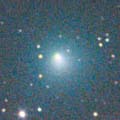
|
It was not visible visually still in February, fainter than 13.9 mag (Feb. 5, Seiichi Yoshida), however, it has been brightening very rapidly as expected after that. Now it is already so bright as 10.4 mag (May 4, Seiichi Yoshida). But, this is fainter than originally expected by 0.5 mag. Strongly condensed, and easy to see. It will reach to 10 mag in spring and summer. It may become a naked-eye object due to the Deep Impact mission on July 4. Actually, this is the first experience in our history, and it is very uncertain what will happen on this comet. Observations are strongly encouraged.
Date(TT) R.A. (2000) Decl. Delta r Elong. m1 Best Time(A, h)
May 7 12 54.23 10 23.3 0.712 1.618 139 10.5 21:52 (180, 45)
May 14 12 52.15 8 44.7 0.718 1.594 133 10.3 21:22 (180, 46)
|
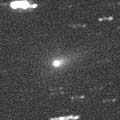
|
It will reach to 10 mag in June and July. It keeps locating rather low in the morning until that. Although it was faint as 15.2 mag on Mar. 14 (Yuji Ohshima), it brightened in April, and finally it became bright enough to be visible visually, 12.3 mag on May 2 (Juan Jose Gonzalez). It seems to be brightening rapidly. It has already reached to 10.6 mag visually on May 7 (Shigeki Murakami).
Date(TT) R.A. (2000) Decl. Delta r Elong. m1 Best Time(A, h)
May 7 23 6.56 19 32.3 1.596 1.299 54 11.4 5:14 (224, 22)
May 14 23 35.41 21 7.2 1.548 1.246 53 11.0 5:19 (222, 21)
|

|
It was 18.5 mag in mid January. The brightening was slower than expected. Although it had been unobservable for a while after that, the ephemeris says it must be brightening rapidly. It will appear in the morning low sky in mid May, so observations are highly encouraged to see the current brightness. In the Northern Hemisphere, it keeps observable for a long time after that, and is expected to reach to 8 mag from July to August. In the Southern Hemisphere, it only appears in the morning very low sky until early June, but not observable when the comet is brightest.
Date(TT) R.A. (2000) Decl. Delta r Elong. m1 Best Time(A, h)
May 7 1 4.11 12 31.5 2.235 1.417 27 12.0 5:14 (250, 7)
May 14 1 10.02 16 57.7 2.131 1.378 31 11.7 5:19 (242, 9)
|

|
Not observable. It was bright as 7.5 mag in early January, easy to see with binoculars. However, it faded and got diffused rapidly in the evening sky since that. It faded to 10.7 mag on Mar. 15 visually (Alexandre Amorim), and 11.5 mag on Apr. 4 by CCD observation (Mitsunori Tsumura), then it became too low. Although it became faint very quickly, the fading pace was slower than usual. It will appear in the morning sky again in August. It may be still brighter than 14 mag at that time and visible visually.
Date(TT) R.A. (2000) Decl. Delta r Elong. m1 Best Time(A, h)
May 7 3 59.00 -6 6.3 3.982 3.123 27 12.3 18:38 ( 88, 8)
May 14 4 2.92 -5 30.2 4.080 3.202 25 12.5 18:33 ( 86, 3)
|
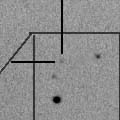
|
The condition of this return is bad. It is not observable around the perihelion passage. It will appear at dawn in July at 14.5 mag, then it will be fading after that. It has already appeared in the morning very low sky in the Southern Hemisphere, but not been observed yet.
Date(TT) R.A. (2000) Decl. Delta r Elong. m1 Best Time(A, h)
May 7 1 28.40 1 21.3 2.492 1.651 26 13.1 5:14 (262, 8)
May 14 1 45.99 2 45.3 2.503 1.687 28 13.3 5:19 (259, 11)
|

|
It was 12.7 mag on May 4, visible visually still now (Seiichi Yoshida). It keeps 12.5-13.0 mag since November, however, now it is smaller and a bit fainter than last autmun while going away from the earth. It will be getting lower while fading after this, so it will be invisible visually soon. The altitude will be lower than 10 deg in late June.
Date(TT) R.A. (2000) Decl. Delta r Elong. m1 Best Time(A, h)
May 7 6 37.27 32 29.2 2.306 1.864 52 13.2 18:38 (143, 10)
May 14 6 57.90 32 12.7 2.364 1.878 49 13.3 18:33 (142, 10)
|

|
It had been brightening rapidly as expected, 19 mag in January and 17 mag in February. However, recent observations reported it was fainter than expected, 15.5 mag still in late April. Maybe the brightness evolution is slower than expected. It is predicted that it keeps visible as bright as 12-13 mag for a long time from May to September. The condition is good in the Southern Hemisphere, but it locates very low in the Northern Hemisphere. In the previous return, it was 1.5 mag brighter than this ephemeris visually. So it can be around 11.0 mag visually at best in this return, too. If it is brightening as expected, it is getting bright enough to be visible visually. But it becomes lowest for the northern observers at 15 deg high from mid April to the end of June. So it will be easier to see visually in July and August.
Date(TT) R.A. (2000) Decl. Delta r Elong. m1 Best Time(A, h)
May 7 16 1.92 -40 17.4 0.834 1.791 152 13.7 1:03 ( 0, 85)
May 14 15 59.52 -40 47.9 0.786 1.760 156 13.4 0:34 ( 0, 84)
|
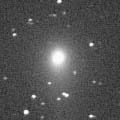
|
Although it had been rather large, well condensed, and easy to see until February, it became diffused in March. However, it keeps bright visually still now, 12.8 mag on May 4 (Seiichi Yoshida). The fading after the perihelion passage is slow, and it will keep visible at 13 mag for a while after this. In the Northern Hemisphere, it keeps the same altitude at 35 deg high in the evening sky until June when it fades down to 14.5 mag.
Date(TT) R.A. (2000) Decl. Delta r Elong. m1 Best Time(A, h)
May 7 5 51.00 70 23.3 3.062 2.698 59 13.7 18:38 (162,-23)
May 14 6 30.65 69 48.9 3.139 2.749 58 13.9 18:33 (163,-21)
|

|
Not observable. It will appear at dawn again in June. It had been always brighter than 13 mag and visible visually all through the season in 2004. In 2005, it is observable in very good condition, almost overhead in the Northern Hemisphere from summer to winter. It can be a good target of observaions if it becomes active as in 2004.
Date(TT) R.A. (2000) Decl. Delta r Elong. m1 Best Time(A, h)
May 7 1 28.26 17 27.7 6.672 5.741 20 13.8 5:14 (249, -1)
May 14 1 33.59 18 2.6 6.633 5.742 26 13.8 5:19 (245, 4)
|
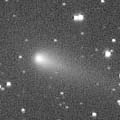
|
Although it had been strongly condensed until early January, it became diffused since late January. It is fading gradually, around 11.5 mag in January and around 12.5 mag in February. It was still bright at 12.6 mag on Mar. 8 (Seiichi Yoshida). Although the brightness evolution before the perihelion passage was extremely rapid, the fading after the perihelion passage is slow as expected. However, it became faint as 13.3 mag on Mar. 29 (A. Baransky), and it is getting lower and lower, so it is getting hard to see visually.
Date(TT) R.A. (2000) Decl. Delta r Elong. m1 Best Time(A, h)
May 7 6 18.98 18 18.3 3.069 2.512 48 14.1 18:38 (130, 19)
May 14 6 32.01 18 14.1 3.161 2.543 44 14.3 18:33 (128, 17)
|

|
It will reach to 9 mag in 2006 spring. In the Southern Hemisphere, it keeps observable until that. In the Northern Hemisphere, it is not observable until 2006 March, except it appears very low in the morning at 12 mag from late August to early September. After 2006 March, northern people can observe it for a long time while it is getting fainter. It had been brightening well as expected until 2005 March. After that, recent brightness is uncertain because it became unobservable in the Northern Hemisphere. It becomes extremely low even in the Southern Hemisphere until June.
Date(TT) R.A. (2000) Decl. Delta r Elong. m1 Best Time(A, h)
May 7 4 25.21 -14 28.8 4.471 3.731 38 14.5 18:38 ( 84, 18)
May 14 4 29.40 -14 32.3 4.422 3.664 36 14.4 18:33 ( 82, 14)
|

|
It is moving northwards and getting observable also in the Northern Hemisphere. It is expected to be bright as 10 mag in early 2006. In the Southern Hemisphere, it keeps locating high until November while the comet is getting brighter gradually. In the Northern Hemisphere, it keeps locating very low around 15 deg high until September. So, it may be too hard to see visually for a long time.
Date(TT) R.A. (2000) Decl. Delta r Elong. m1 Best Time(A, h)
May 7 20 31.81 -36 7.6 3.508 3.887 104 15.0 5:14 (288, 86)
May 14 20 34.88 -36 21.6 3.347 3.819 110 14.8 5:08 ( 0, 89)
|

|
It was faint as 16.5 mag in early February. Then it has been brightening as expected, and reached to 15.2 mag in late April (Apr. 27, Ken-ichi Kadota). It will be observable in good condition at 14.5-15 mag until mid July. Because it locates high, it will be visible visually with a large telescope when the sky is clear. It was observed visually at 15.0 mag on May 7 (Shigeki Murakami).
Date(TT) R.A. (2000) Decl. Delta r Elong. m1 Best Time(A, h)
May 7 16 54.80 12 57.8 2.625 3.443 138 15.0 1:57 (180, 42)
May 14 16 37.09 14 22.0 2.577 3.434 142 14.9 1:12 (180, 41)
|
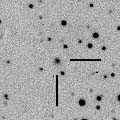
|
It brightened from 18 to 15 mag during one year from the end of 2003 to early 2005. The brightness evolution was much faster than that of a typical comet. It will become too low in the evening at 15 mag in June. Then it can be 13 mag and may be visible visually in next winter. However, after it reached to 15.2 mag in December and January at opposition, it is getting a bit fainter and 15.5 mag still in March, although it should have brighten slowly by calculation.
Date(TT) R.A. (2000) Decl. Delta r Elong. m1 Best Time(A, h)
May 7 6 8.30 46 15.2 6.384 5.778 49 15.1 18:38 (147, -4)
May 14 6 15.84 46 9.3 6.428 5.755 44 15.0 18:33 (145, -6)
|

|
It brightened rapidly from 19 to 17 mag in early 2004. But it is in normal state now, brightening gradually. It was 15.7 mag on Apr. 9. It keeps 15-16 mag for a long time until early 2007. It is also visible visually at 14.3 mag (May 7, Juan Jose Gonzalez).
Date(TT) R.A. (2000) Decl. Delta r Elong. m1 Best Time(A, h)
May 7 15 54.54 -19 42.8 2.245 3.233 165 15.2 0:56 (180, 75)
May 14 15 49.54 -19 44.7 2.215 3.222 173 15.1 0:24 (180, 75)
|

|
New bright periodic comet discovered in 2004 spring. In last year, it had been bright at 15.0-15.5 mag from spring to summer. The ephemeris says it keeps brighter than 19 mag even around the aphelion, however, the comet had not been discovered before 2004. This suggested the comet became bright temporarily last year. But actually, it keeps the brightness for more than one year until now, 15.3 mag on Mar. 11. In this year, it is expected to be as bright as last year from spring to autumn. It may be also visible visually at 14 mag.
Date(TT) R.A. (2000) Decl. Delta r Elong. m1 Best Time(A, h)
May 7 20 22.03 -27 9.4 2.513 2.940 104 15.2 5:14 (194, 82)
May 14 20 26.29 -27 41.1 2.434 2.948 110 15.1 4:59 (180, 83)
|

|
It reached to 13 mag and was observed visually in good condition in 2004 autumn. Then it has been fading on and on while being apart from the earth. It will be low in the evening sky at 16.5 mag in August. It will be observable again in 2006, at 16.5 mag from March to April, then it will go away. Next return is in 2018, when it will be 14.3 mag at best.
Date(TT) R.A. (2000) Decl. Delta r Elong. m1 Best Time(A, h)
May 7 6 52.99 58 16.9 2.537 2.209 59 15.6 18:38 (159, -9)
May 14 7 20.89 56 49.6 2.608 2.241 57 15.7 18:33 (159, -8)
|
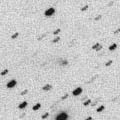
|
A comet with a retrograde orbit passed the perihelion at the end of March, and it also became closest to the earth at opposition at the same time, then it became bright momentarily while passing each other. Because the brightness evolution was very slow actually, it did not became as bright as expected. However, it reached to 13.9 mag on Apr. 4 by CCD observation (Mitsunori Tsumura). It must have been visible visually too, but no visual observations were reported probably due to the low altitude. It will fade out rapidly after this. It has already become so faint as 15.6 mag on Apr. 27 (Akimasa Nakamura). It will be too low in the evening sky at 16 mag in May, so it immediately becomes unobservable.
Date(TT) R.A. (2000) Decl. Delta r Elong. m1 Best Time(A, h)
May 7 8 41.94 -5 37.1 1.869 2.097 88 15.7 18:38 (152, 58)
May 14 8 34.96 -3 16.1 2.051 2.117 79 15.9 18:33 (143, 52)
|
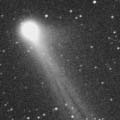
|
Fading gradually as predicted. It had been visible visually at 14 mag until January. But it became too faint to see visually after February. It will be 17 mag in June.
Date(TT) R.A. (2000) Decl. Delta r Elong. m1 Best Time(A, h)
May 7 9 23.03 -3 34.0 4.991 5.220 97 16.2 18:38 (172, 58)
May 14 9 22.72 -3 2.3 5.178 5.289 90 16.3 18:33 (162, 57)
|

|
Recovery of a peculiar asteroid 2004 FS101 discovered in 2004 spring. Although it was 18 mag in mid January, it brightened to 16.7 mag in mid March. The brightness evolution was rather faster than that of a typical comet. It will be 14.5 mag around 2006 January, although it will be rather low for the northern observers. It keeps observable at 15-16 mag for a long time from 2005 spring to the end of 2006. Because it moves in the northern sky, it keeps observable for a long time in the Northern Hemisphere.
Date(TT) R.A. (2000) Decl. Delta r Elong. m1 Best Time(A, h)
May 7 13 47.10 47 31.4 3.705 4.216 113 16.3 22:44 (180, 7)
May 14 13 39.67 48 25.7 3.734 4.175 109 16.2 22:09 (180, 7)
|

|
It brightened rapidly in January and reached to 13 mag. It was 12.8 mag, small as 0.9 arcmin, and unexpectedly rather well condensed (Mar. 8, Seiichi Yoshida). After it passed the perihelion in late February, it kept bright at 13 mag in March, and it was still visible visually as 13.2 mag on Mar. 31 (Edwin van Dijk). However, it faded rapidly in April, and become so faint as 15.1 mag on Apr. 27 (Akimasa Nakamura). It seems to be a comet which brightens and fades rapidly just around the perihelion passage. It will be too low in the evening at 17.5 mag in June.
Date(TT) R.A. (2000) Decl. Delta r Elong. m1 Best Time(A, h)
May 7 7 19.91 27 56.4 1.801 1.587 61 16.4 18:38 (148, 19)
May 14 7 43.63 28 1.1 1.879 1.626 59 16.6 18:33 (148, 19)
|
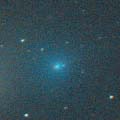
|
It was bright and large in early January, 11 mag and 2-5 arcmin. But it has been fading very rapidly as expected after that. It was visible visually still on Apr. 5 at 13.8 mag, but it became invisible visually, fainter than 13.8 mag, on May 3 (Seiichi Yoshida). It is already so faint as 17.0 mag on even by CCD observation (Apr. 29, Akimasa Nakamura). It will be fainter than 18 mag in June.
Date(TT) R.A. (2000) Decl. Delta r Elong. m1 Best Time(A, h)
May 7 12 17.48 16 5.5 1.333 2.118 128 16.4 21:16 (180, 39)
May 14 12 19.23 14 49.1 1.432 2.162 123 16.8 20:50 (180, 40)
|

|
Peculiar comet which becomes brightest about 5 months after the perihelion passage. It became brightest in February, about 5 months after the perihelion passage, as expected. However, it is fainter than expected in this return, and reaches to 15.5 mag at best. It was not visible visually, fainter than 14.0 mag (Feb. 5, Seiichi Yoshida).
Date(TT) R.A. (2000) Decl. Delta r Elong. m1 Best Time(A, h)
May 7 10 13.82 30 14.1 2.725 3.026 97 16.4 19:12 (180, 25)
May 14 10 18.65 29 23.0 2.831 3.045 92 16.6 18:50 (180, 26)
|

|
It came closer to the earth and reached to 15.5-16 mag from January to March by CCD observations. It was also visible visually at 14.3 mag (Feb. 6, Reinder J. Bouma). However, it will be getting apart from the earth after this, and getting fainter on and on. Although it is still bright as 16.5 mag in mid April, it will be fainter than 18 mag in June.
Date(TT) R.A. (2000) Decl. Delta r Elong. m1 Best Time(A, h)
May 7 9 34.20 24 40.6 1.813 2.096 91 17.0 18:38 (179, 30)
May 14 9 45.92 22 7.8 1.908 2.129 88 17.2 18:33 (176, 33)
|

|
Now it is brightest, 16.8 mag on May 4 (Akimasa Nakamura). However, many other observers reported it so faint as 18-19 mag, probably because of the weak condensation. About one year ago, in 2004 spring, it was reported as 18 mag (J. Lacruz, A. Sanchez). But Hirohisa Sato pointed out those observations have large residuals. So, they must be mistakes, probably measurements of background stars. Actually it must have been fainter than 20 mag in 2004.
Date(TT) R.A. (2000) Decl. Delta r Elong. m1 Best Time(A, h)
May 7 15 6.90 -25 11.2 1.619 2.620 171 17.1 0:09 (180, 80)
May 14 15 2.35 -24 10.5 1.610 2.616 172 17.1 23:32 (180, 79)
|

|
It had been fading rather faster than usual since the perihelion passage in 2004 spring. However, the fading turned to be slow after the end of 2004. It was already 15.4 mag on Dec. 16, then it kept almost constant brightness and 15.8 mag still on Mar. 6 (Akimasa Nakamura). It may be observable at 16 mag for a while after this. It still keeps bright as 16.7 mag on Mar. 26 (Ken-ichi Kadota).
Date(TT) R.A. (2000) Decl. Delta r Elong. m1 Best Time(A, h)
May 7 9 47.55 33 59.1 4.539 4.665 90 17.2 18:46 (180, 21)
May 14 9 48.77 32 58.5 4.708 4.730 85 17.3 18:33 (177, 22)
|

|
Because it is a far object, it has been observed at 17.5 mag for one and a half year since 2003 summer. It has already passed the perihelion, so it will become a bit fainter this year. But it keeps 18 mag until summer.
Date(TT) R.A. (2000) Decl. Delta r Elong. m1 Best Time(A, h)
May 7 15 43.23 44 36.2 6.843 7.367 117 17.8 0:45 (180, 10)
May 14 15 35.04 44 42.8 6.875 7.384 116 17.9 0:09 (180, 10)
|
|
![]()
 C/2003 K4 ( LINEAR )
C/2003 K4 ( LINEAR ) 10P/Tempel 2
10P/Tempel 2 32P/Comas Sola
32P/Comas Sola 37P/Forbes
37P/Forbes C/2004 Q1 ( Tucker )
C/2004 Q1 ( Tucker ) 29P/Schwassmann-Wachmann 1
29P/Schwassmann-Wachmann 1 78P/Gehrels 2
78P/Gehrels 2 C/2004 B1 ( LINEAR )
C/2004 B1 ( LINEAR ) C/2005 E2 ( McNaught )
C/2005 E2 ( McNaught ) C/2004 K1 ( Catalina )
C/2004 K1 ( Catalina ) C/2003 WT42 ( LINEAR )
C/2003 WT42 ( LINEAR ) 117P/Helin-Roman-Alu 1
117P/Helin-Roman-Alu 1 P/2004 F3 ( NEAT )
P/2004 F3 ( NEAT ) (944) Hidalgo
(944) Hidalgo C/2004 L1 ( LINEAR )
C/2004 L1 ( LINEAR ) C/2002 T7 ( LINEAR )
C/2002 T7 ( LINEAR ) C/2005 B1 ( Christensen )
C/2005 B1 ( Christensen ) 49P/Arend-Rigaux
49P/Arend-Rigaux 62P/Tsuchinshan 1
62P/Tsuchinshan 1 121P/Shoemaker-Holt 2
121P/Shoemaker-Holt 2 C/2004 RG113 ( LINEAR )
C/2004 RG113 ( LINEAR ) 91P/Russell 3
91P/Russell 3 C/2003 T3 ( Tabur )
C/2003 T3 ( Tabur ) C/2003 O1 ( LINEAR )
C/2003 O1 ( LINEAR )![]()























